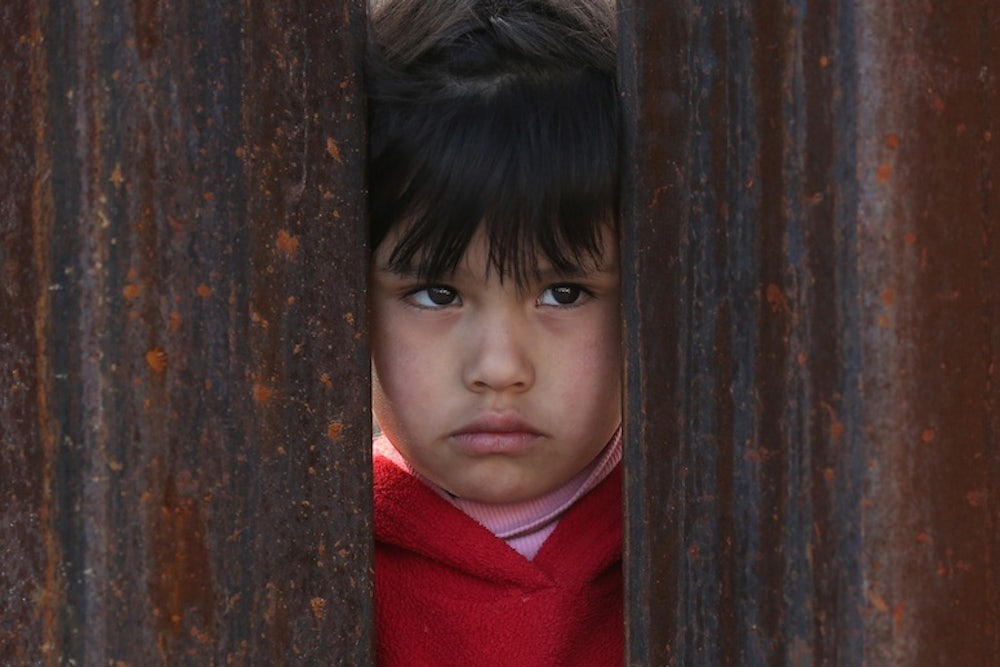When President Obama addressed the child-migrant crisis at the U.S. border on Wednesday evening, he struck a can-do, just-send-me-a-bill-already tone. "I'm interested in solving a problem," he declared. "Let's go ahead and fix it." But as he surely knows, there are no simple solutions here; there may not be any non-simple solutions, either. In the very immediate future, his administration faces two key challenges: 1) how to treat the children who are here humanely and 2) how to respond without encouraging even more families in Central America to dispatch their kids on the perilous journey north. Those two imperatives are almost certainly in conflict with each other, and if I had to guess which one gets short shrift in the coming weeks, my bet would be on option one.
As the administration expands its detention facilities to house the growing numbers of unaccompanied kids—52,000 since October, and counting—it is taking care to provide them with stuffed animals and Mylar blankets and phone banks where they can try to contact relatives they may have in the U.S. But it is also warehousing children behind chain-link fences in cramped and crowded holding cells. The reflexive move to detain kids en masse, without considering the less punitive alternatives available, is cause for concern in itself. When the U.S. immigration system is operating at its best, it's sluggish, opaque, and shockingly unresponsive to the circumstances of individual human beings; right now, that system is chronically overloaded. Makeshift solutions, like the detention centers the government is hastily arranging, all too often turn into semi-permanent humanitarian nightmares, where the trauma that drove the kids here in the first place is multiplied by the trauma of bewildering and uncertain confinement.
But the conditions in which the kids are housed is, if anything, the smaller part of the problem. The bigger issue is the administration's insistence on returning child migrants back to their home countries as fast as it possibly can. Politically, this makes sense; and as a deterrent to families in Central America, it makes a lot of sense too. And yet the fact remains that many of these children are fleeing real and inescapable violence, and by deporting them indiscriminately, the U.S. will be putting some of them in danger.
Earlier this year, the UN High Commission for Refugees interviewed more than 400 children who arrived unaccompanied at the border from Honduras, Guatemala, and El Salvador. They documented stories like this one, from a 17-year-old from El Salvador:
The problem was that where I studied there were lots of M-18 gang members, and where I lived there was under control of the other gang, the MS-13. The M-18 gang thought I belonged to the MS-13. They had killed the two police officers who protected our school. They waited for me outside the school. It was a Friday, the week before Easter, and I was headed home. The gang told me that if I returned to school, I wouldn't make it home alive. The gang had killed two kids I went to school with, and I thought I might be the next one. After that, I couldn't even leave my neighborhood. They prohibited me. I know someone who the gangs threatened this way. He didn't take the threats seriously. They killed him in the park. He was wearing his school uniform. If I hadn't had these problems, I wouldn't have come here.
Or this one from a 15-year-old girl, also from El Salvador:
I am here because I was threatened by the gang. One of them "liked me." Another gang member told my uncle that he should get me out of there because the guy who liked me was going to do me harm. In El Salvador, they take young girls, rape them and throw them in plastic bags. My uncle told me it wasn't safe for me to stay there and I should go to the United States.
The sane, rational, compassionate response would be to treat these children as asylum seekers, and evaluate whether, for some of them, returning home is too great a risk. At the absolute minimum, the U.S. should end the farce that a ten-year-old is competent to explain to a Border Patrol agent or immigration judge, without any guarantee of legal representation, why he or she meets the current statutory requirements for asylum or delayed removal as a resident of a non-contiguous nation. At the same time, the administration would be undertaking policies to help stem the flow of child migrants from their home countries.
Tackling these problems purely on a practical level is complicated enough—the U.S. immigration system is notoriously dysfunctional no matter which party is in power. But responding to the crisis within the current political environment, which compels Obama to publicly maintain a rigid focus on border security and swift deportations in order to have a hope of getting any money out of Congress, is aneurism-inducing. The only simple conclusion to draw from this situation is that none of this is simple and none of this is easily fixed.
